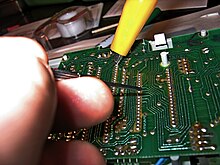Circuit bending
Circuit bending , an aleatoric art of music, involves the creative short-circuiting of electronic devices with low voltage with the aim of creating new musical or visual instruments and sound generators. By emphasizing spontaneity and chance , the techniques of circuit bending are mainly associated with the music genre noise , although conventional musicians and music groups have also experimented with so-called bent instruments .
With circuit bending, the device housings are usually opened and additional components such as electronic switches and potentiometers are often installed, which change the circuit .
Experimental process
Circuit bending is mostly carried out through experiments based on do-it-yourself principles with second-hand electronics. Inexpensive keyboards or drum computers , small digital synthesizers , battery-operated guitar effect devices, but also electronic children's toys that are not intended for music production are used as starting instruments. While the output instruments have a planned and well thought-out electronic sound design, Circuit bending is characterized above all by the unplanned, chance-based, experimental modification of the instruments. Although ready-made “circuit bent” instruments can often be purchased on eBay, for example , the use of such a “ready-made” device contradicts the idea of circuit bending and is rejected by some of the supporters of this movement. This is countered by the fact that established bands mostly play such externally made "circuit bent" instruments and this has contributed significantly to making circuit bending better known.
Circuit bending is typically used to transform or transform an audio device by removing the back cover of the device and connecting any two circuit points with a "jumper" cable that conducts current from one point on the circuit to another. The result is monitored either by the internal loudspeakers of the device or by an amplifier connected to the audio output with speakers connected. When an interesting effect is achieved, this connection is marked for future use or retained directly by soldering or clamping the connection points. Often other components are built in at this point, such as toggle switches that are used to toggle the effect on and off; or components such as resistors or capacitors are added to change the quality of the audio output. This is repeated on the principle of trial and error . Other components that are added to the circuits can affect and expand the expressive possibilities. These can be potentiometers, photocells (for reaction to light), pressure sensors and the like.
One of the simplest circuit-bending variations is the "body contact" (English, in German for example: "body contact"). The sound is changed by the user touching the circuit with his bare hand. Metal buttons, plates or screws are often attached to these circuit points so that the user can easily and precisely reach certain points by hand to bridge. Some of these are attached outside of the still existing housing.
philosophy
While the technique is often viewed as just a method of creating " sounds " that are not intended by the manufacturer, circuit bending is viewed by some as a more spiritual process. In the popular video What is Circuit Bending? Artists describe circuit bending as “parallel worlds within circuits that shouldn't actually exist, but they are there”,… “it's more control over our chaos. And that's what it's about, "..." an explosive psychedelic surreal world of sound. "These views suggest that the sounds achieved are present as hidden potential in every circuit, and that it is the task of Circuit bending to explore and to develop the potential of a device through experiments.
Founder / Inventor
Although similar methods have previously been used by other musicians and instrument makers, this way of creating music or sound is usually attributed to Reed Ghazala , who has been shown to use the term as early as the 1960s. Ghazala experience with Circuit bending began in 1966 when a toy transistors - amplifiers briefly closed by accident to a metal part of his desk, which led to a series of unusual sounds. While Reed Ghazala does not claim to be the first circuit-bender, he coined the term circuit-bending and disseminated its concepts and applications through his publications and through his website. This earned him the title "Father of Circuit Bending" ("Father of Circuit Bending").
Publications
Artists who build “bent instruments” themselves or who only use them were presented on a compilation CD entitled “Noise and Toys, Volume 1”, which was officially released in 2006 on “We Are… Records”. Tiger Claw Records in Madison, Wisconsin specializes in circuit bending artists and released a 12-band compilation in 2006 entitled "The Blown Circuit Comp - A Tribute to Circuit Bending" and a second compilation CD in 2007 with the Title "DO NOT BEND", on which 19 bands were presented. The company Absurdity.Biz has been creating video documentations about circuit bending since 2003. So far it has released three DVDs of the Bent Festival in 2004, 2005 and 2006.
Security notice
In devices operated with mains voltage (recognizable by the type plate, on the mains cable or a socket for mains voltage), lethal voltages occur. There is a risk of an electrical accident when touching conductive parts inside the open housing.
See also
Individual evidence
- ^ Reed Ghazala : http://www.anti-theory.com/soundart/circuitbend/cb14.html
- ^ Reed Ghazala: Circuit-Bending, Build Your Own Alien Instruments , Extreme Tech , 2006
- ^ Reed Ghazala : "Circuit-Bending and Living Instruments," EMI Volume VIII # 1, 1992
Web links
- Circuit Bending on Oddmusic.com , Gallery of Reed Ghazala's work with history, instructions and tools
- Ghazala's How-To , Homepage of Reed Ghazala
- Getlofi.com , blog with content about Circuit Bending
- Bent Festival , International Circuit Bending Festival
- Absurdity.Biz , Circuit Bending Documentation with videos
- [1] , Circuit Bending Collection with audio examples
- Casper Electronics , technical aids and individual creations in the field of circuit bending
- taz.de Article about circuit bending, known as the aleatory art of music

